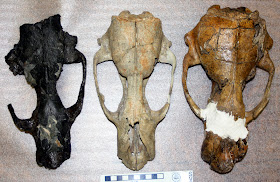 After our last day of research at NHMLAC, Sarah, Morgan, and I drove to LAX to drop Morgan off for his flight back to the rockies. Sarah and I continued on, and had a two day trip planned ahead: first, we would visit the Page Museum of La Brea Discoveries in Hollywood, and then we'd drive north on Highway 1 from Santa Monica north through Malibu, Oxnard, Santa Barbara, Santa Maria, San Luis Obispo, Big Sur, and eventually through Monterey on our way back to the San Francisco area. We took a ton of great photos at the Page Museum which we arrived at just before opening; I've included some of the better and more informative photos here.
After our last day of research at NHMLAC, Sarah, Morgan, and I drove to LAX to drop Morgan off for his flight back to the rockies. Sarah and I continued on, and had a two day trip planned ahead: first, we would visit the Page Museum of La Brea Discoveries in Hollywood, and then we'd drive north on Highway 1 from Santa Monica north through Malibu, Oxnard, Santa Barbara, Santa Maria, San Luis Obispo, Big Sur, and eventually through Monterey on our way back to the San Francisco area. We took a ton of great photos at the Page Museum which we arrived at just before opening; I've included some of the better and more informative photos here.The front of the uniquely designed Page Museum. The museum is shaped like a square with a botanical garden courtyard, and above the museum, a large bas-relief is supported by that scaffolding.
A poor Columbian Mammoth is in deep... stuff.
 My wife snapped this photo of tar bubbling up outside the museum. It's amazing how much tar is still seeping up. On my last visit in 2004, I didn't see anything around the park that was half this good; you can clearly see here the leaf litter and detritus that covers and camouflages the tar, while also seeing some obviously viscous, black, cartoon style tar bubbling up.
My wife snapped this photo of tar bubbling up outside the museum. It's amazing how much tar is still seeping up. On my last visit in 2004, I didn't see anything around the park that was half this good; you can clearly see here the leaf litter and detritus that covers and camouflages the tar, while also seeing some obviously viscous, black, cartoon style tar bubbling up.The famous Pit 91 excavation, which is temporarily on hold during the project 23 excavation a stone's throw away.
One of the panels from the bas relief above the museum, depicting a teratorn confronting a ground sloth.
A Columbian Mammoth skeleton, which I look way too happy to see (considering it's not marine, that is).
One of these things is not like the other ones...
My wife attempting to pull the plunger, showing how damned difficult it is.
The right canine is not the thing that's important in this shot, it's the left canine; although this is not a marine carnivoran, I'm interested in tooth eruption in carnivorans in general, and this made my day.
Skull and life restoration of Merriam's giant condor, Teratornis merriami. Still not as big as Pelagornis, but impressive and terrifying none the less.
Lots and lots of dire wolves (Canis dirus). This has to be my favorite display in the entire museum... it's beautifully constructed.
The spectacularly large and robust skeleton of the American Lion, Panthera atrox.
 What? I thought this was the American Lion? Some recent studies have indicated the skull and mandibular morphology of Panthera atrox is more similar to the extant Jaguar (Panthera onca) than it is to African Lions (Panthera leo). There is a conflicting molecular study done with ancient DNA, however, but I'll save that for another time. Here's a question for any readers in the know: who the hell is Naegele? Joseph Leidy named the damn thing after all, so why isn't it named Leidy's Giant Jaguar?
What? I thought this was the American Lion? Some recent studies have indicated the skull and mandibular morphology of Panthera atrox is more similar to the extant Jaguar (Panthera onca) than it is to African Lions (Panthera leo). There is a conflicting molecular study done with ancient DNA, however, but I'll save that for another time. Here's a question for any readers in the know: who the hell is Naegele? Joseph Leidy named the damn thing after all, so why isn't it named Leidy's Giant Jaguar?A new American Lion specimen named "Fluffy" was recently excavated, and there was this temporary case which had in it what I thought was one of the better exhibits in the whole place: a three dimensional representation of the skeleton, using the same skeletal elements of a housecat. As a taphonomist, I particularly enjoyed this.
The bubble prep lab at the Page.
I love seeing stuff like this in prep labs. Apparently Arctodus is a patriot.
Is that a walrus in there? Damn, it's just a Smilodon. I really loved this display showing the three dimensional configuration of bones.
Smilodon again.
A bee outside the Page Museum. This has no relevance to the rest of the post, but it is a pretty picture, no?
A composite of two panoramic shots my wife took showing the bas relief.
A great shot taken by my wife of the wall of dire wolf skulls.
Hollywood!
Up next: Southern California Research Trip, Part 5 - detailing the Santa Barbara Museum, the coast, and the conclusion of the series of posts.






















































